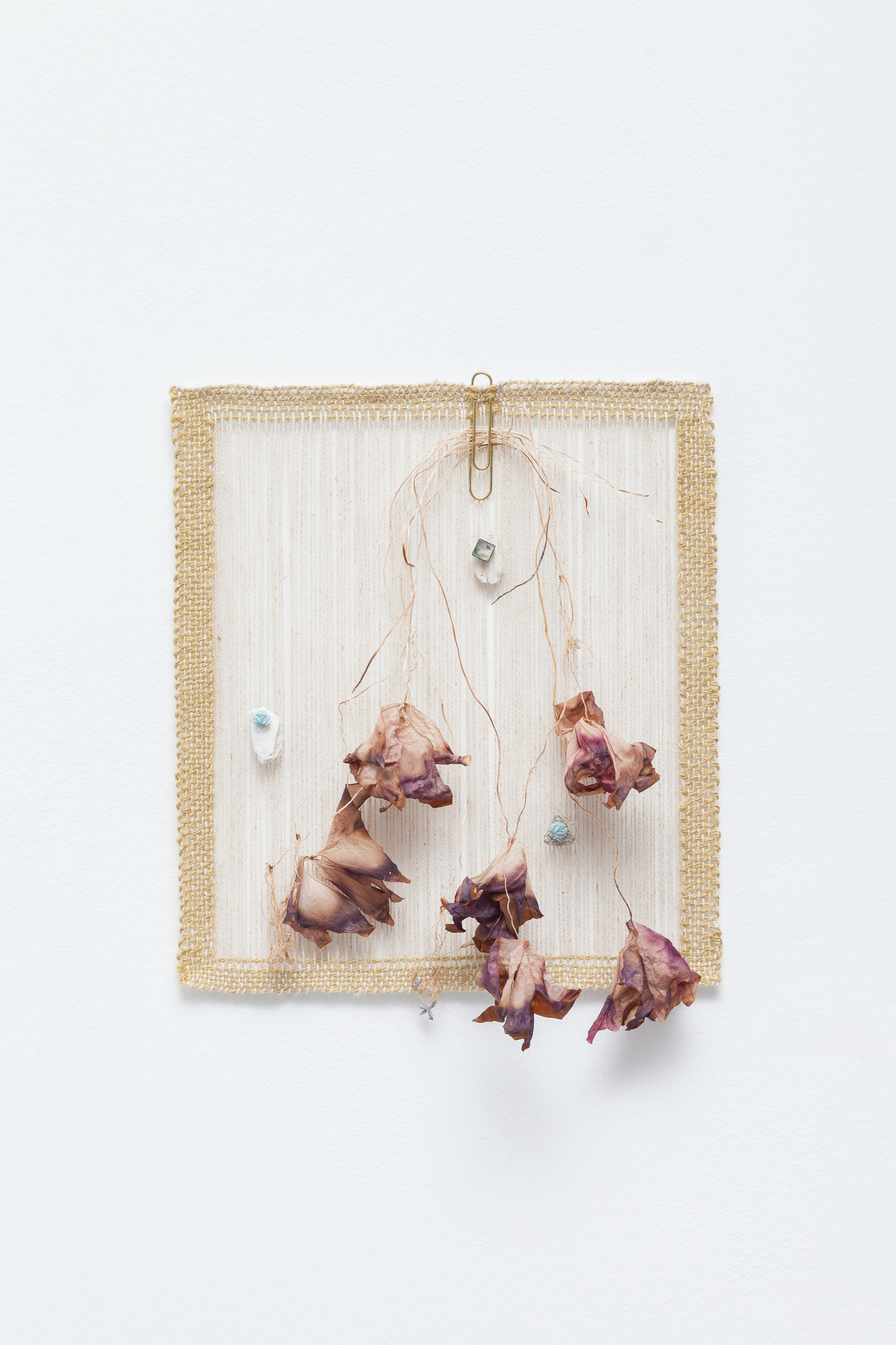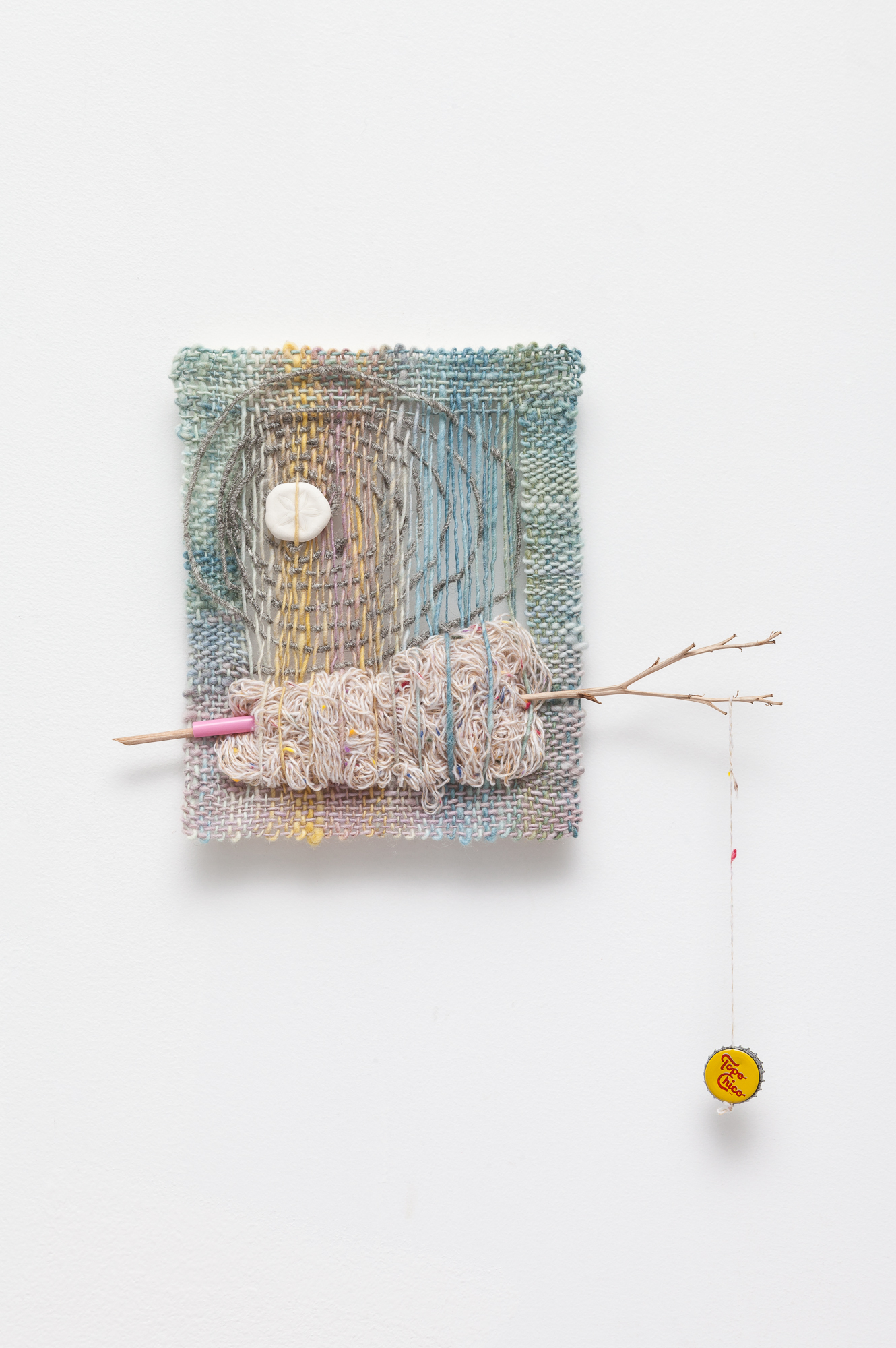
Some of the most tender cigarettes I’ve ever seen are in a weaving in “Some Kind of Duty,” one of two shows currently on view at the DePaul Art Museum. There are dozens of them in “The White Album (Cigarettes),” one of over forty works in the show by fibers artist kg Gnatowski (MFA Fiber and Material Studies 2007), who is also Adjunct Assistant Professor in the Department of Fiber and Material Studies at School of the Art Institute of Chicago (SAIC). The artist categorizes the size of their tapestries in general terms, and this one, at ten feet tall and eight feet wide, would certainly count as “extra-large.” The cigarettes, each one smoked within an inch of its life, stick out of small circles woven like mouths, the heads turning in different directions. The orange filters sit tightly against white wool, which is held taut and vertical by a border of burnt sienna and umber. The strands of wool are pulled and gathered in different directions, like sections of hair separated for a braid, or a curtain that shows all the times someone has peeked through it.
Gnatowski’s weavings incorporate everyday items and objects that might have been pulled from a curiosity cabinet. Some are woven into the structure of the tapestry and some are delicately affixed to its surface. In “Cancerian,” a lily brooch, a pale snail shell, and a pendant depicting a crab make the weaving feel like an offering. The objects are illuminated through the poems kg has written to accompany their sketches of each weaving in the gallery guide. The poem for “Cancerian” reads, in part:
pinned with a brooch which is a lily
which dies most beautifully
according to this angel who saved my life one time
on chenille thats makes the plaid that makes the dog the first
hooked with my mothers sign
The poems serve as an intimate materials lists. For a piece that is made from wool, the poem comes with the addendum, “from the rug we tripped on every morning for breakfast.” They describe people who have gone and relationships that have changed through objects that become placeholders for those memories. The title of this show is a phrase from Joan Didion’s book “A Year of Magical Thinking,” where Didion writes about mourning her husband, an acknowledgement of kg’s bereavement over their father’s death. In their work, materials like a straw, a plastic bag, and an earring are all treated with reverence. Like old movie ticket stubs one might inexplicably hold onto, these objects become talismanic.

The show is charmed by kg’s exaltation of weaving practices. Certain works immediately reveal a harmony of unexpected materials. “Red Plum” weaves a plastic bag with bright red yarn to evoke a plastic container of strawberries. In “An American Prayer,” a bud of weed hangs like a pendant necklace. It is flanked by two dead moths and surrounded by a woven border that looks like the color of beets until you get close and see its colors cycle through the rainbow.
The upstairs gallery has been transformed into two playable badminton courts. Kg has crocheted the nets, half of which look like a typical net, while the other half sags and skips loops, dangling a rabbit’s foot, a bottle cap, and a colored pencil, among other enchanted items. To play, grab one of the rackets — heavy with a stiff net painted purple, pink, and yellow — made in collaboration with Betsy Odom, whose show, “Butchcraft,” is in the adjacent room.
The badminton court is a great introduction to Odom’s work, which often returns to sports as a place to explore the performance of gender. The objects in “Butchcraft” are heavy and seductive. There are over thirty sculptures lined up on one long shelf. The works are not organized according to material or theme. Instead, Odom prompts the viewer to consider a sleek modernist-style sculpture in the same breath as a hot pink batter’s helmet.
The vibrant “Bulldog 27: Batting Helmet” lovingly recreates the sport accessory in a way that renders it impractical. Pieces of pink leather, so saturated they almost glow, are stitched together to create the form. Leather often carries masculine connotations, but Odom exploits the tradition of leathercraft to fit her queer, butch vision. There are flowers carved on the surface that present an unexpected femininity embedded in the craft. Look closely, and you’ll find a hole in the back to accommodate a ponytail.

The heft of the materials and the precision of the artist’s hand give the sculptures a bodily feeling. In the center of the works is “Gym Shorts,” made of reddish-brown leather and carved with long-stemmed flowers. It is displayed so the shorts appear to be upside down, the hole for each leg wide open. The hand-stitched white thread emphasizes the curves of the seams. One seam runs through the center and disappears between the legs, suggestively inviting you to peer into the object. In Odom’s hands, even banal household items carry a layer of sexuality. “Bandaids” is made of leather and shaped to look like two pair of band-aids crossing each other like an “X,” evoking a pair of pasties.
Amidst these corporeal objects, Odom winks at the viewer with “Bowling Pin.” The sculpture is made of wood and sits on an inch-high plaster pedestal. The work is an interpretation of a bowling pin, with the bottom exaggerated and the top reduced to look like a nipple. The pedestal suggests that a bowling pin is not so different from a Brancusi sculpture.
The procession of sculptures begins and ends with works from an ongoing series called “Handkerchiefs.” Handkerchiefs have been used by queer communities to signal sexual preferences, and while most histories focus on how they have been used by gay men, Odom provides a more expansive interpretation. Each work in the series is made from a different material and manipulated to look like a folded handkerchief. Some of them display a delicate flourish, like a sculpture made of foam, which unfurls like the crest of an ocean wave. A handkerchief made from cork is thicker and looks more like a work rag recently pulled from a denim pocket. I kept returning to the work made from a pale green bar of soap, which appeared like a tidy pair of gloves. The sculptures in “Handkerchiefs” are an homage to the hanky code, but instead of relying only on color and placement to communicate specific desires, Odom presents work that uses material and form to mimic the nuance of sexuality.
Both artists imbue everyday objects with intimacy. For kg, the intimacy is tender; for Odom, it feels raw and physical. For artists who subvert preconceived notions about their crafts, underestimated objects become tools for mischief, presenting viewers with something both familiar and disrupted.
“Karolina Gnatowski: Some Kind of Duty” and “Betsy Odom: Butchcraft” are on view at DePaul Art Museum through March 31, 2019.







